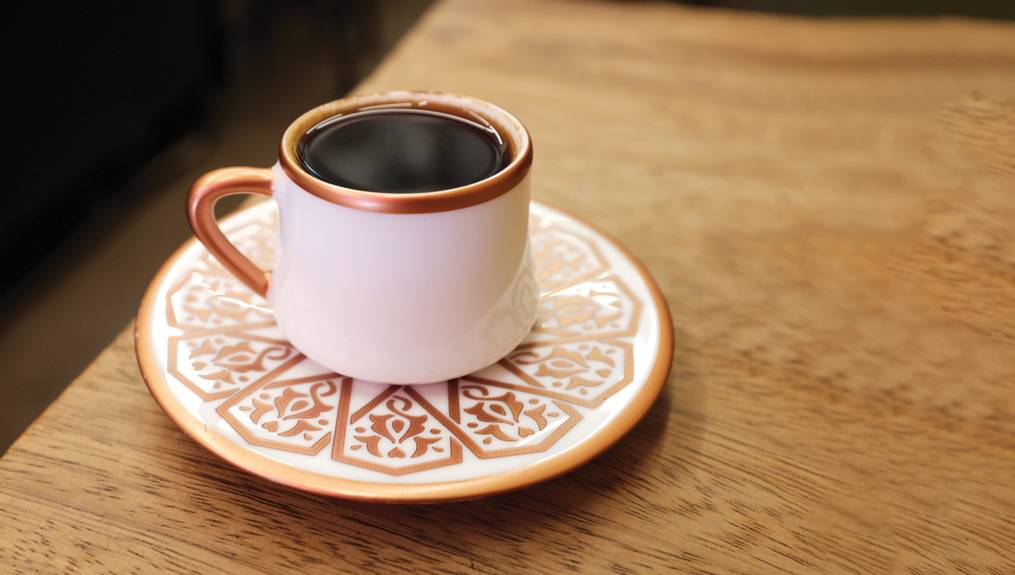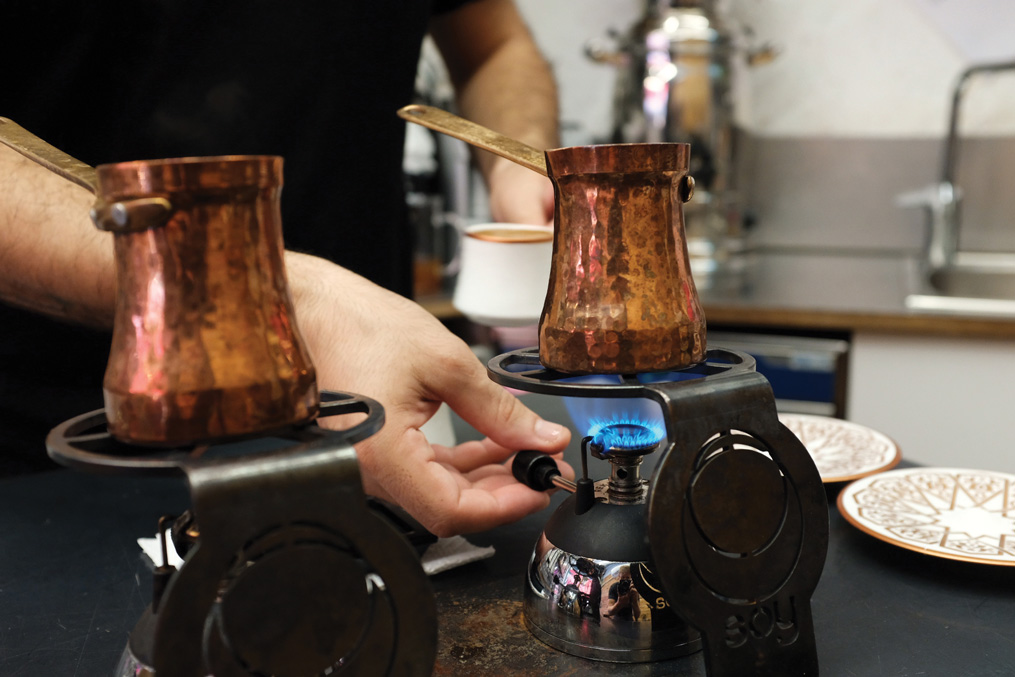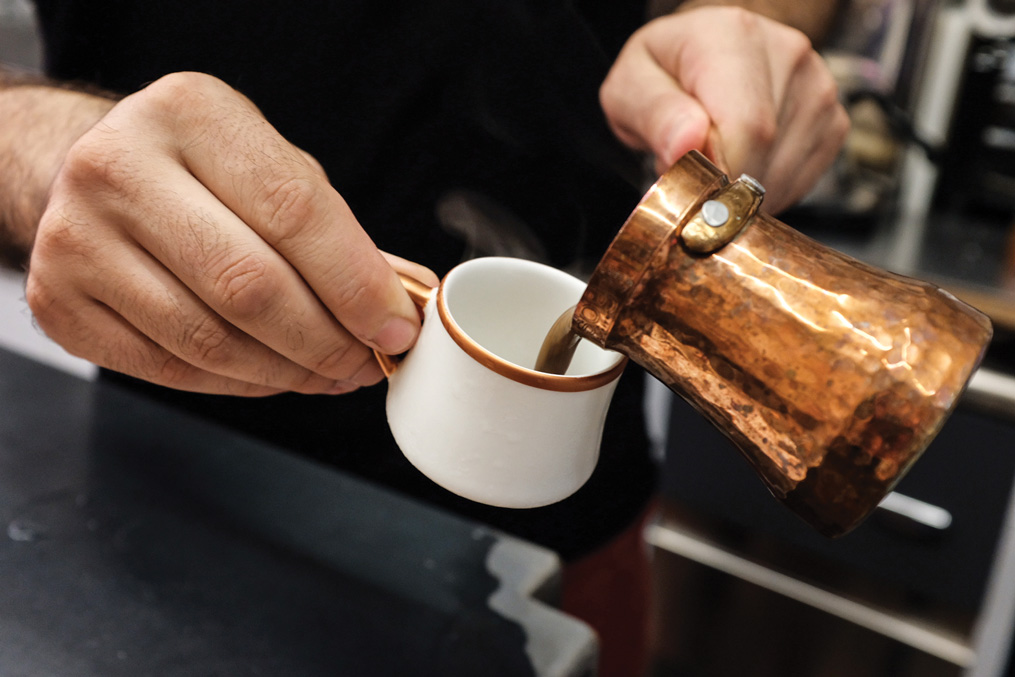Turkish coffee at Coffee Manifesto in Istanbul. Photo by Michael Butterworth
New Life for an Ancient Brew Method
The barista at Coffee Manifesto in Istanbul’s Kadıköy district measures out a small dose of coffee and turns the dial on the Mahlkönig EK-43 clockwise, almost as fine as the grinder goes. In seconds, the coffee is ground into a fine dust and is carefully shaken into a small copper pot with a long handle. The grounds are mixed with tepid water and given a quick stir with a small wooden paddle.
With a few clicks, a butane burner ignites with a flash of flight. The barista carefully adjusts the burner until the blue flames are just lapping over the sides of the copper cezve.
Within minutes, the concoction slowly begins to bubble. Suddenly, the foam billows up, threatening to overflow before the barista swiftly removes the cezve from the heat source. In one careful motion, the entire mixture, grounds and all, is poured into a small cup— a sort of inverted espresso demitasse with a wider base than lip. The steaming hot coffee must sit for several minutes as the grounds are allowed to settle to the bottom.
This is one of the oldest coffee brewing methods, and for many people around the world, is still what comes to mind when you say “coffee.” Although dozens of nationalities claim a coffee culture centered around a cezve or ibrik, the concentrated, unfiltered brew is perhaps best known as Turkish coffee, and a growing number of specialty coffee professionals are rediscovering the method’s potential.
“Cezve reveals in full the taste of the coffee,” says Tetiana Tarykina, the 2019 Ukrainian Cezve/Ibrik Champion. (In Turkish, an ibrik is a pitcher and a cezve is a small-handled pot used to make coffee. Curiously, the former word is often used to describe the latter in English and other languages.)

Tetiana Tarykina’s
Turkish Coffee
- Add 7.5g of Turkish ground coffee and 60ml of water to the cezve.
- Place over medium-high heat.
- Stir at 0:30, 1:00, and 1:30.
- Decant mixture into Turkish coffee cup when the slurry starts to foam up.
- Total brew time should
be 2:30.
Photo courtesy of Tetiana Tarykina
Tarykina finished second at the 2019 World Cezve/Ibrik Championship, a World Coffee Events competition in which competitors prepare multiple coffees, including a signature beverage, with cezves for a panel of judges. Although the competition attracts less attention than its sister WCE competitions the World Barista Championship and Brewers Cup, for cezve enthusiasts, the antique brewing technique is equally worthy of a place in the spotlight.
“Cezve is a very difficult but interesting brewing method,” says Tarykina. “It is a concentrated coffee beverage that makes it difficult to hide coffee defects.”
It’s not uncommon to hear coffee roasters anecdotally mention their roasts perform better on the cupping table than when brewed. Like in cupping, Turkish coffee doesn’t filter out the insoluble compounds that are typically trapped by a filter. The result is a substantive, coating mouthful—a chance for consumers to experience another side of the coffee.
“Mouthfeel and sweetness are more important for Turkish coffee,” says Turgay Yıldızlı, the 2013 World Cezve/Ibrik Champion and founder of Specialty Turkish Coffee, an online Turkish coffee equipment supplier based in New Orleans. “A smooth, round mouthful makes the fruity or floral notes more pleasant.”
It’s a sentiment perhaps best echoed by a T-shirt Specialty Turkish Coffee stocks. On the shirt, the outline of a cezve surrounds the words, “We don’t filter people or coffee”—a riff on the popular poster by Department of Brewology.
The unfiltered consumption of Turkish coffee helps create its unique flavor profile, but so does the heat application used during brewing.
“This is a very primitive brewing method,” says Yıldızlı. “Decoction.”
Most brewing methods, be it a pour-over dripper or French press, start with almost-boiling water that will cool slightly during brewing. In the case of siphon brewers, the slurry is held at a constant temperature. But Turkish coffee starts with tepid water that is heated, meaning most of the extraction happens at the very end of the brew.
Turkish coffee is far from the only method that uses decoction to extract coffee solubles. In Ethiopia and Eritrea, a jebena is used to brew coffee, typically heated directly over a fire. A similar tradition exists in Scandinavia, where kokkaffe is made by boiling coffee in a kettle before using fir leaves as a makeshift filter.
Although much older, Turkish coffee is perhaps more analogous to Italy’s espresso culture: small, strong cups of coffee that are brewed to-order one or two cups at a time. The comparison is perhaps fitting, considering the Venetians first acquired coffee through trade with the Ottoman Empire.
Although Coffea arabica is endemic to Ethiopia, the plant was brought to Yemen by the 15th century. Turkish historians M. Sabri Koz and Kemalettin Kuzucu observe in their book Turkish Coffee the spread of coffee cultivation in Yemen coincided with the Ottoman golden age, during the reign of Sultan Süleyman I. At the time, Istanbul was the capital of a vast empire that stretched across North Africa and Eastern Europe, all the way into modern-day Iraq and the Persian Gulf.
Prior to the Ottoman conquest of Yemen, coffee had mostly been consumed for medicinal purposes or in religious ceremonies by Sufi monks, but it soon became the empire’s social beverage of choice. In the early 1500s, the first coffeehouse opened in Istanbul’s Tahtakale neighborhood, and the new trend soon spread throughout the whole city. The sultan employed a team of full-time coffee makers, and many other officials followed suit.
“It became a luxury item to serve your guests,” says Yıldızlı. “Hospitality and guests are very important in Eastern cultures.”
Although it’s been almost a century since the last sultan reigned in Istanbul and the Ottoman Empire was replaced by the modern nation state of Turkey, the way that coffee is prepared in much of the former empire remains the same.
“Every second Ukrainian family has a cezve at home,” says Tarykina.
Likewise, travel to Serbia, Cyprus, or Egypt, and you’ll find locals sipping on cezve-brewed coffee, though they likely all have different names for their brew of choice.
“The name is a problem,” says Yıldızlı. “Is it Turkish coffee? Greek coffee? Cezve coffee? Ibrik coffee?”
As a Turkish-American, Yıldızlı is partial to the name Turkish coffee, though he recognizes the method belongs to many cultures.
“Know the history,” says Yıldızlı. “And you can change the tradition.”
For those hoping to add Turkish coffee to their café menus, certain challenges abound.
“There’s not enough information around,” says Yıldızlı. “There’s a bias that it’s too bitter.”
Like crema for traditional Italian espresso, the köpük, or foam, on top of the cup is typically taken as a sign of quality. To maximize foam, traditional recipes in Turkey call for bringing the coffee to its boiling point multiple times, cooling the coffee in between. But for Yıldızlı, repeatedly heating the coffee will over-extract it, producing a harsh, bitter cup.
To prevent over-extraction, baristas can manipulate other brew variables. For example, most Turkish coffee recipes call for stronger coffee-to-water ratios that serve to balance out the fine grind and intense turbulence. Yıldızlı prefers to start with a 1:10 ratio when dialing in a new coffee; Tarykina opts for an even stronger recipe, using 7.5 grams of coffee to 60ml of water.
Yıldızlı further breaks from convention by starting with warm (50–60 degrees Celsius) water, to shorten the overall brew time and avoid over-extraction. Still, he recommends that aspiring cezve users experiment with different recipes, and trust their palate.
“There is no standard evaluation of this brew method,” says Yıldızlı.
For those interested in developing their Turkish coffee brewing skills, Yıldızlı and Tarykina recommend investing in a high-quality cezve. With the direct heat application to the device, it’s important to look for a thick copper cezve with a silver lining to avoid corrosion. Both Yıldızlı and Tarykina partner with SOY, which makes cezves by hand in their Istanbul factory. (Specialty Turkish Coffee is SOY’s U.S. distributor, and Tarykina works as a brand ambassador.)
“These cezves are made from a single piece of copper, which allows for good thermal conductivity,” she says. “Each detail is very unique.”
At a time when pour-overs are passé and latte art is commonplace, Yıldızlı sees an opportunity for cafés to create memorable, interactive coffee experiences for their customers with Turkish coffee. Although it’s one of the world’s oldest brew methods, it has an enduring intrigue both for those who grew up with it or without.
While traditional Turkish coffee is served either black or sweetened with sugar, Tarykina sees signature beverages as a great way to introduce cezve coffee to a new audience.
“I like to brew cezve with pink peppercorns, grated dark chocolate, and dried cherries,” she says. “Cezve is a method you shouldn’t be afraid to experiment with.”


















